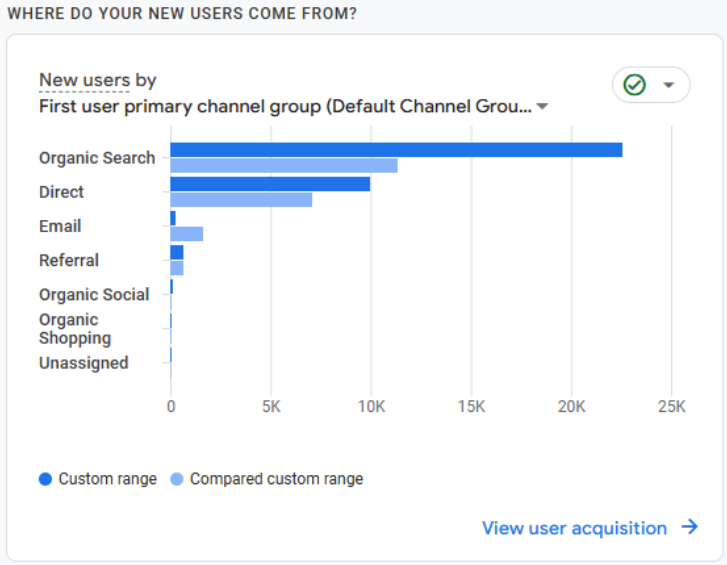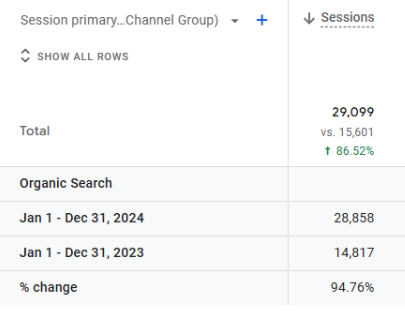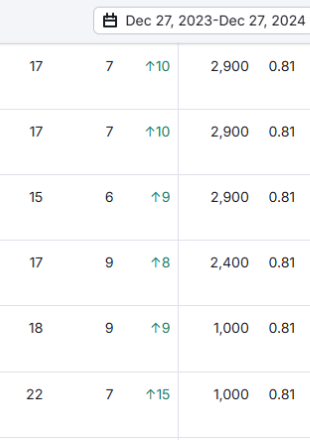Case Study 2:
How Strategic SEO Supercharged a Local Registry’s Traffic

Client Overview
A registry office with over 28 years of service in Strathmore and the surrounding area, bringing over 50 years of combined expertise to the community. As an authorized Alberta Registries agent, they offer a wide range of services, including Motor Vehicles, Land Titles, Vital Statistics, Alberta Health, and Corporate Registration support.
Objectives and Challenges
A local registry office was looking to improve its visibility on Google for a newly launched online service. While they had a steady SEO strategy in place, results had stalled, and organic traffic wasn’t growing as expected.
It became clear that a more focused and flexible approach was needed. The plan shifted to smarter keyword research, better content tailored to what users were actually searching for, and stronger local SEO to help them stand out in their community. By closing gaps in their current strategy and staying in step with changing search trends, the registry set out to boost traffic and build a stronger online presence.
SEO SERVICES
Services Provided
Through these tailored SEO services, we successfully helped our clients strengthen their online presence, attract more qualified leads, and grow their businesses effectively in a competitive digital landscape.
Implementation Process
Trufla’s comprehensive SEO program is designed to meet the unique needs of the Registry, focusing on impactful strategies for sustainable growth: The program focused on improving search engine visibility, enhancing user experience, and driving qualified leads across key products.
- Conducting a full technical website audit to identify and resolve errors and critical issues.
- Enhancing organic search rankings through targeted Local SEO and on-site optimization.
- Strategically targeting high-volume keywords with manageable difficulty to maximize visibility.
- Developing dedicated news landing pages and blog content to establish topical authority and attract relevant traffic.
- Building high-authority backlinks to boost the competitiveness of the newly added service in a challenging market.
- Creating engaging content for practice area pages and refining website architecture for an improved user experience.
Results and Outcomes
Organic Sessions Growth: Organic sessions increased by an impressive 94% year-over-year, demonstrating significant improvements in website visibility and user engagement.
( Source: Google Analytics. )
Consistent Growth in Organic Clicks: Throughout 2024, the graph highlights a steady rise in organic clicks, reflecting successful optimization efforts.
(Source: Google Search Console)
Year-Over-Year Traffic Comparison: A side-by-side comparison of organic traffic in 2023 (dotted line) versus 2024 (solid line) shows a clear upward trend, indicating sustained growth.
(Source: Google Analytics)
Increase in New User Traffic: Organic traffic from new users showed a notable year-over-year increase, showcasing improved outreach and audience expansion.
(Source: Google Analytics)
User Engagement: Key user engagement metrics increased by 19%, signaling enhanced website usability and relevance to visitors.
( Source: Google Analytics. )
Transaction Completion Rate: Users completing online transactions grew by 86% over a six-month period, highlighting the effectiveness of optimization strategies in driving conversions.
(Source: Google Analytics 4)
Organic Traffic Trends: A snapshot of organic traffic trends from Google shows a strong upward trajectory, further validating the performance improvements.
( Source SEMRush )
Keyword Positioning Improvements: Several target keywords saw significant ranking improvements on Google when comparing December 2023 to December 2024, showcasing strengthened competitiveness in search results.
( Source SEMRush )
SEO Services: FAQs
SEO helps companies improve their online visibility, attract qualified leads, and rank higher in search engine results. A well-optimized site increases organic traffic, enhances credibility, and drives conversions.
Key strategies include:
- Keyword Research: Targeting industry-specific and location-based keywords.
- On-Page SEO: Optimizing title tags, meta descriptions, headers, and content.
- Technical SEO: Improving site speed, mobile-friendliness, and crawlability.
- Local SEO: Optimizing Google My Business and local citations.
- Content Marketing: Creating blogs, FAQs, and guides.
- Link Building: Earning authoritative backlinks to boost credibility.
Keywords help search engines understand your services. Using the right mix of high-volume and long-tail keywords ensures your website appears for relevant searches, increasing the chances of attracting potential customers.
The time it takes to see SEO results for new website depends on several factors, including the site’s current authority, competition, and the effectiveness of the SEO strategy. Generally, noticeable improvements can take 8 to 10 months, while significant traffic and ranking boosts may take 14 to 20 months or longer.






